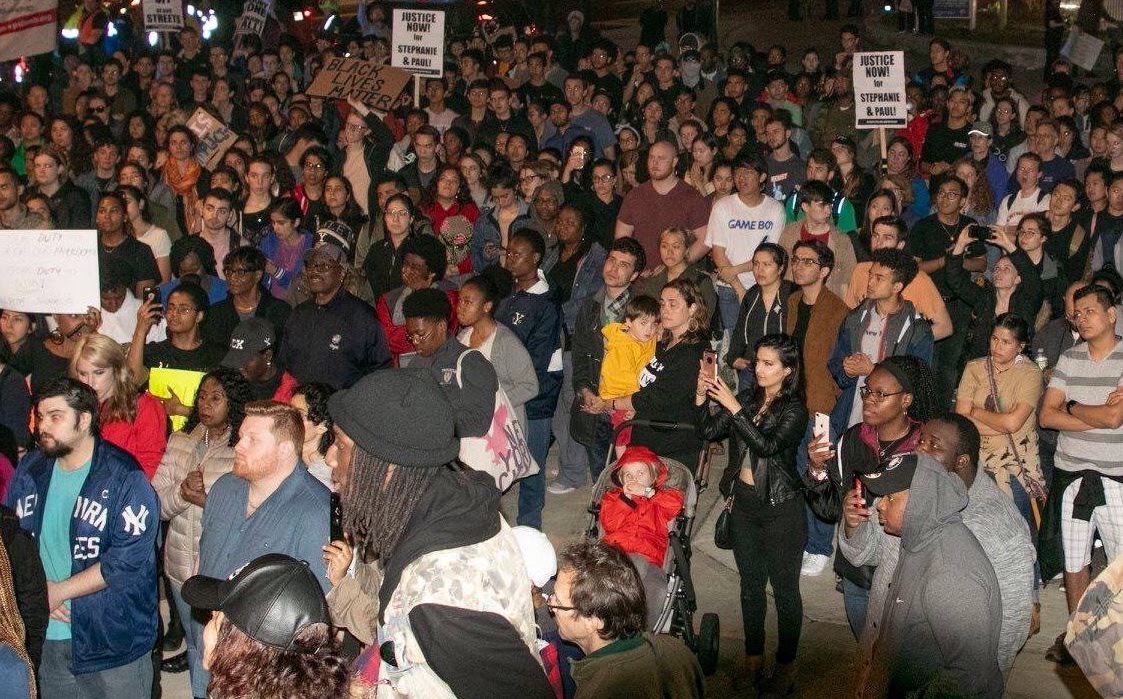Associate Professor of Sociology Cassi Meyerhoffer studies the role of race in American policing, as well as systemic racism and racial residential segregation, but her work on these issues extends beyond the classroom. Last spring, when police shot at an unarmed couple in the Newhallville neighborhood of New Haven, Meyerhoffer was among the many New Haven and Hamden residents – as well as Southern and Yale students – who spoke out and showed up at numerous peaceful demonstrations around the city. In the widely-publicized incident, 22-year-old Stephanie Washington was shot and seriously wounded by a Hamden police officer and a Yale police officer, who fired 16 rounds at her and Paul Witherspoon, the driver of the car in which she was a passenger. Witherspoon was not injured. The police were responding to a 911 call of a reported armed robbery at a mini-mart, but at the time of the shooting, neither Witherspoon nor Washington was in possession of a firearm.
“In my classes I have more and more black women and Latinx folks,” Meyerhoffer says. “I want my students to see that there are things they can do about what we’re discussing in the classroom. They get frustrated.”
After the shooting in Newhallville, she says, “students were just thrown. They felt that could have been them.”
Meyerhoffer is just back from a fall sabbatical during which she worked on her book proposal: From the Old Jim Crow to the New: Reconstruction, Residential Segregation and the Policing of Black Bodies. Policing of neighborhoods is a particular area of interest for her, and she says that Newhallville is “an over-policed neighborhood,” drawing attention from the Hamden and Yale police departments as well as New Haven’s. Meyerhoffer points out that while the police who fired at Washington and Witherspoon were Hamden and Yale police, Newhallville is not within their jurisdiction. “We have students living in these neighborhoods,” she says. “Every semester I hear stories from students of color – it could be our students that these things are happening to.”
“Black and brown neighborhoods are over-policed,” Meyerhoffer says. “We know this as social scientists. When we talk about white privilege, we’re also talking about the luxury of not walking around feeling threatened all the time.” She adds that living under constant stress contributes to deterioration of health in black and brown people.
Meyerhoffer writes in her book proposal, “As public discourse around police brutality and racial inequality largely centers on specific events, there is a dearth of information within the public discourse about systemic racism and how race and racism pervade every single aspect of American life. The ways in which Black and Brown people are often treated by law enforcement is reflective of larger historical racial inequities and injustices that extend far beyond the criminal justice system.” In the book, she plans to show how “the racist foundations of America [are tied] to discrimination in our criminal justice system, schools, and neighborhoods.”
Prior to coming to Southern in 2012, Meyerhoffer did work related to racial composition of neighborhoods. She says that “there’s this American idea that people want to live around people like them,” and that this notion supposedly explains the racial segregation of neighborhoods. But, she says, this segregation is actually the result of government policies, and writes, “It was not one policy that led to the segregation of American neighborhoods, but a series of policies and laws enacted by our government. Federal, state, and local governments used public housing policy, redlining, blockbusting, and banking and lending regulations to purposely segregate every metropolitan area in the nation.”
The systemic racism Meyerhoffer sees implicit in neighborhood segregation is connected to what she calls “the policing of black bodies.” She writes, “When residential segregation is coupled with stereotypes about black people, black neighborhoods, and black criminality, we are left with a culture in which black bodies are over-policed, treated more harshly by our criminal justice system, and are rarely characterized as victims when police use excessive force and are rarely held accountable for such force.”
One positive outcome of the Newhallville incident, Meyerhoffer says, is how the three communities – New Haven, Hamden, and Yale — have come together over it in working for justice. Meyerhoffer says she participated in the protests as part of a larger group, led chiefly by black women.
People all over the state in black and brown communities are taking action, Meyerhoffer says, adding, “I think it’s important for our students to see that it takes all of us to do the work of disrupting white supremacist institutions — including faculty and students — and it can’t be done comfortably from one’s office or classroom. It requires showing up for our communities.”


